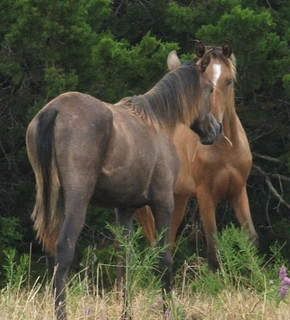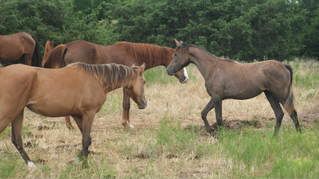In the horses' eyes
 I often see horses in stories that are just kinda hanging around in the background; too many authors tend to move them around like cardboard cutouts being placed around a set.
I often see horses in stories that are just kinda hanging around in the background; too many authors tend to move them around like cardboard cutouts being placed around a set.
It doesn't have to be that way. It's not that hard to get inside a horse's head and let them add a little flavor and depth to your scene.
The main thing to remember is that horses, while they can be aggressive, protective and dominant, are prey animals. Their instincts are geared toward survival: food, water and protection from predators.
A horse's first line of defense from predators is escape and so you have to consider that anything that inhibits that escape - in the horse's mind - puts that horse's life at risk. Domestic horses have to be taught to let their handlers pick up their hoofs for cleaning and farrier work - remember that with one leg off the ground, especially if someone is holding it, the horse has no escape should a wolf pack round the corner. So, effectively, holding a horse's hoof in your hand is - in their mind - the equivalent of holding their life.
The same with the ears. There are times that the horse's ears must be handled, for cleaning or bridling, but without their ears being free, again - in the horses mind - they are placing their life in the handler's hands ... trusting the handler's ears to hear the scrap of a claw on a rock or the whuff of hot breath on the breeze.
Any time the wind is high, that also inhibits the horses' abilities to hear an approaching predator. If you need a normally well mannered horse to give your hero grief, whip up a thunderstorm with some high winds and the horse will be dancing around in the breeze, trying to do triple duty with his eyes since he can't hear or smell predators from downwind.
In these photos, the year-old TELPE has just been released back into the pasture after a couple of days of being stalled and she's eager to reaffirm existing relationships. Specifically, who will protect her from predators, who will she need to protect. See how she's flaring her nostrils and perking her ears? "I can smell and hear very well," she's saying.  Notice that both TELPE and MIREE are moving, while SHAHIN, the red mare, has all four hoofs firmly planted. That's quite deliberate. SHAHIN is the 'boss mare' and as such, she moves her feet for no one. With the simple act of being immobile, she reassures TELPE that she'll lead her to feed and water and protect her from predators.
Notice that both TELPE and MIREE are moving, while SHAHIN, the red mare, has all four hoofs firmly planted. That's quite deliberate. SHAHIN is the 'boss mare' and as such, she moves her feet for no one. With the simple act of being immobile, she reassures TELPE that she'll lead her to feed and water and protect her from predators.
Always remember that your hero may be able to quiet a skittish horse simply by being still and strong.


2 comments:
Cool - I love how you include photos to show the dynamics. And I'd never really thought of horses as having a 'prey' mentality, especially since they're so huge and can use their hooves the way they can.
Good thoughts, Sue! Thanks.
Poor Horatius - he's got an unreliable horse to begin with, and there's always wind in the Pennine Hills near Vindolanda. *grin*
Your posts give me some interesting ideas.
Post a Comment